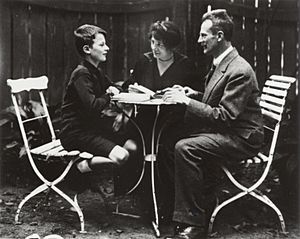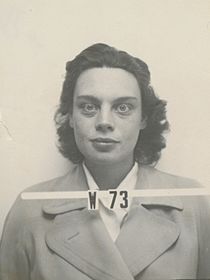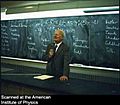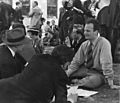Hans Bethe facts for kids
Quick facts for kids
Hans Bethe
|
|
|---|---|
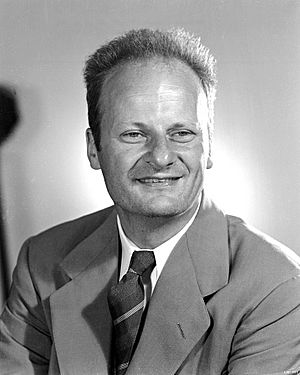 |
|
| Born |
Hans Albrecht Bethe
July 2, 1906 |
| Died | March 6, 2005 (aged 98) Ithaca, New York, U.S.
|
| Nationality | German American |
| Alma mater | University of Frankfurt University of Munich |
| Known for |
|
| Spouse(s) |
Rose Ewald (married in 1939; two children)
|
| Awards |
|
| Scientific career | |
| Fields | Nuclear physics |
| Institutions | |
| Thesis | Theorie der Beugung von Elektronen an Kristallen (1928) |
| Doctoral advisor | Arnold Sommerfeld |
| Doctoral students |
|
| Other notable students | Freeman Dyson |
| Signature | |
Hans Albrecht Bethe ( July 2, 1906 – March 6, 2005) was a German-American theoretical physicist who made major contributions to nuclear physics, astrophysics, quantum electrodynamics, and solid-state physics, and who won the 1967 Nobel Prize in Physics for his work on the theory of stellar nucleosynthesis.
Early life
Bethe was born in Strasbourg, which at the time was part of the Reichsland Elsaß-Lothringen, Germany, on July 2, 1906, the only child of Anna (née Kuhn) and Albrecht Bethe, a Privatdozent of physiology at the University of Strasbourg.
Bethe attended the Goethe-Gymnasium in Frankfurt, Germany. His education was interrupted in 1916, when he contracted tuberculosis, and he was sent to Bad Kreuznach to recuperate. By 1917, he had recovered sufficiently to attend the local Realschule and the following year, he was sent to the Odenwaldschule, a private, coeducational boarding school. He attended the Goethe-Gymnasium again for his final three years of secondary schooling, from 1922 to 1924.
Having passed his Abitur, Bethe entered the University of Frankfurt in 1924. He decided to major in chemistry. The instruction in physics was poor, and while there were distinguished mathematicians in Frankfurt such as Carl Ludwig Siegel and Otto Szász, Bethe disliked their approaches, which presented mathematics without reference to the other sciences.
Bethe entered the University of Munich in April 1926.
Career
Bethe became a naturalized citizen of the United States in March 1941. For most of his career, he was a professor at Cornell University.
During World War II, he was head of the Theoretical Division at the secret Los Alamos laboratory that developed the first atomic bombs. There he played a key role in calculating the critical mass of the weapons and developing the theory behind the implosion method used in both the Trinity test and the "Fat Man" weapon dropped on Nagasaki in August 1945.
After the war, Bethe also played an important role in the development of the hydrogen bomb, although he had originally joined the project with the hope of proving it could not be made. Bethe later campaigned with Albert Einstein and the Emergency Committee of Atomic Scientists against nuclear testing and the nuclear arms race. He helped persuade the Kennedy and Nixon administrations to sign, respectively, the 1963 Partial Nuclear Test Ban Treaty and 1972 Anti-Ballistic Missile Treaty (SALT I).
During the 1980s and 1990s, Bethe campaigned for the peaceful use of nuclear energy. After the Chernobyl disaster, Bethe was part of a committee of experts who analysed the incident. They concluded that the reactor suffered from a fundamentally faulty design and also that human error had contributed significantly to the accident.
In 1995, at the age of 88, Bethe wrote an open letter calling on all scientists to "cease and desist" from working on any aspect of nuclear weapons development and manufacture.
His scientific research never ceased and he was publishing papers well into his nineties, making him one of the few scientists to have published at least one major paper in his field during every decade of his career, which in Bethe's case spanned nearly seventy years. Freeman Dyson, once his doctoral student, called him the "supreme problem-solver of the 20th century".
Personal life
Bethe's hobbies included a passion for stamp-collecting. He loved the outdoors and was an enthusiastic hiker all his life, exploring the Alps and the Rockies.
Bethe married Rose Ewald, the daughter of Paul Ewald, on September 13, 1939, in a simple civil ceremony. She had emigrated to the United States and was a student at Duke University and they met while Bethe was lecturing there in 1937. They had two children, Henry and Monica. (Henry was a contract bridge expert and former husband of Kitty Munson Cooper.)
He died in his home in Ithaca, New York, on March 6, 2005, of congestive heart failure. He was survived by his wife and their two children. At the time of his death, he was the John Wendell Anderson Professor of Physics, Emeritus, at Cornell University.
Honors and awards
Bethe received numerous honors and awards in his lifetime and afterward. He became a Fellow of the American Academy of Arts and Sciences in 1947, and that year, he also received the National Academy of Sciences's Henry Draper Medal and was elected to the American Philosophical Society. He was awarded the Max Planck Medal in 1955, the Franklin Medal in 1959, the Royal Astronomical Society Eddington Medal and the United States Atomic Energy Commission Enrico Fermi Award in 1961, the Rumford Prize in 1963, the Nobel Prize in Physics in 1967, the National Medal of Science in 1975, the Oersted Medal in 1993, the Bruce Medal in 2001, and posthumously in 2005, the Benjamin Franklin Medal for Distinguished Achievement in the Sciences by the American Philosophical Society.
Bethe was elected Foreign Member of the Royal Society (ForMemRS) in 1957, and he gave the 1993 Bakerian Lecture at the Royal Society on the Mechanism of Supernovae. In 1978 he was elected a Member of the German Academy of Sciences Leopoldina.
Cornell named the third of five new residential colleges, each of which is named after a distinguished former member of the Cornell faculty, as the Hans Bethe House after him. Similarly named after him is the Hans Bethe Center, 322 Fourth Street NE, Washington, D.C., home to the Council for a Livable World, where Bethe was a longtime board member, as well as the Bethe Center for Theoretical Physics at University of Bonn in Germany. An asteroid, 30828 Bethe, that was discovered in 1990 was named after him. The American Physical Society Hans Bethe Prize was named after him as well.
Images for kids
-
Bethe's Los Alamos Laboratory ID badge
See also
 In Spanish: Hans Bethe para niños
In Spanish: Hans Bethe para niños


